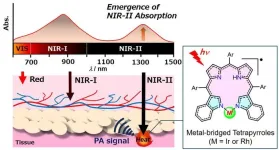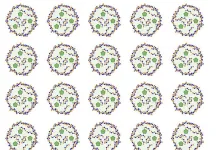(Press-News.org) Boston – A data analysis from a randomized clinical trial for stage 3 colon cancer patients by investigators at Dana-Farber Brigham Cancer Center found that patients with evidence of residual cancer in their blood after surgery to remove the cancer, may benefit from adding of celecoxib, to post surgery treatment. The analysis showed that patients with positive blood tests for circulating tumor DNA (ctDNA) had worse outcomes in general, but those who were treated with celecoxib, a non-steroidal anti-inflammatory drug, experienced significantly improved disease-free survival.
“This is one of the first studies to show that ctDNA status has predictive utility in terms of selecting patients that respond better to a drug,” says Jonathan Nowak, MD, PhD, a pathologist at Dana-Farber Cancer Institute and Brigham and Women's Hospital who presents the study at the American Society of Clinical Oncology Gastrointestinal Cancers Symposium on Jan. 25, 2025, in San Francisco, Calif.
“These results add to our earlier findings that celecoxib improves survival for PIK3CA mutated colon cancer,” says Jeffrey Meyerhardt, MD, MPH, senior author and co-director of the Colon and Rectal Cancer Center at Dana-Farber Cancer Institute. “These findings will help develop a personalized approach to additional therapy for patients with early-stage colon cancer.”
Patients with stage 3 colon cancer are initially treated with surgery to remove the cancer in the colon and nearby lymph nodes. After this treatment, they typically receive adjuvant chemotherapy intended to reduce their risk of the cancer coming back. In a subset of these patients, however, the cancer returns, potentially rendering them incurable. A key research focus at Dana-Farber is finding ways to improve adjuvant therapies and stave off recurrence.
To investigate the use of celecoxib on disease-free survival in patients with stage 3 colon cancer, Meyerhardt and colleagues initiated a randomized clinical trial, the CALGB (Alliance)/SWOG 80702 trial, in 2010 with the Alliance for Clinical Trial in Oncology and the National Cancer Institute. The trial enrolled 2,526 patients between 2010 and 2015. After treatment, patients were randomized to receive adjuvant chemotherapy with fluorouracil, leucovorin, and oxaliplatin (FOLFOX) for three or six months with or without daily celecoxib for three years. Those taking celecoxib showed a moderate benefit, but the results, which were published in 2021, were not statistically significant.
Evidence has since emerged suggesting that anti-inflammatory drugs might benefit some patients with colon cancer, but not others. One possibility for this is that patients who have a blood test soon after surgery showing evidence of ctDNA have a higher risk to relapse and may benefit from additional therapies beyond standard chemotherapy. In this new study, investigators wanted to explore whether anti-inflammatory drugs might help stave off relapse in patients whose ctDNA test was positive soon after surgery.
When the original prospective celecoxib clinical trial was designed a decade ago, patients were assessed before and after surgery using imaging, which reveals where cancer cells have clustered, but has limited resolution. The ctDNA tests available today provide a more sensitive read on whether cancer remains after surgery by detecting microscopic fragments of tumor DNA in the blood.
The study team identified 1,011 of 2,526 patients who had participated in the original trial and had agreed to have blood drawn for research purposes that was available for analysis. They performed ctDNA tests on blood samples taken after surgery. This analysis revealed that patients with positive ctDNA generally had worse outcomes. However, those with positive ctDNA tests who had been prescribed celecoxib in addition to standard chemotherapy had significantly improved disease-free survival compared to those who received only standard chemotherapy. For those who had negative ctDNA tests, there was no significant difference between those taking celecoxib versus placebo.
“Based on this analysis, the benefits of celecoxib with chemotherapy look promising for early-stage colon cancer patients with positive ctDNA after primary treatment,” say the investigators. “This evidence plus results from other ongoing studies will help determine which patients may benefit from celecoxib in addition to other standard treatments.”
Funding: The Alliance for Clinical Trials in Oncology Foundation, National Cancer Institute, Natera, Inc.
END
Blood test could guide use of anti-inflammatory drug celecoxib to reduce risk of colon cancer recurrence
2025-01-25
ELSE PRESS RELEASES FROM THIS DATE:
Blood test from Alliance trial guides use of anti-inflammatory drug to lower colon cancer recurrence risk
2025-01-25
The Alliance for Clinical Trials in Oncology today announced the results of a data analysis from a randomized phase III clinical trial involving patients with stage III colon cancer, which found that adding the drug celecoxib to treatment after surgery might help those who still have traces of cancer in their blood. The analysis showed that patients with signs of cancer in their blood measured by Signatera™, a circulating tumor DNA (ctDNA) test, tended to have worse outcomes. However, those who took celecoxib after surgery had a much better chance of staying cancer-free. These results are being presented in a late-breaking ...
New dyes pave way for better photothermal cancer treatment and diagnosis
2025-01-25
Tokyo, Japan – Researchers from Tokyo Metropolitan University have developed a new dye that can strongly absorb second near-IR radiation and transform it to heat. Starting with a dye from the bile pigment family, they designed a unique ring structure which can bind rhodium and iridium. Measurements and modeling revealed strong second near-IR absorptions and exceptional photostability. Second near-IR waves easily penetrate human tissue; the new dye may be applied in deep tissue therapies and imaging.
The second near-IR region of the electromagnetic spectrum (1000-1700 nanometers) ...
New drug shows promise in restoring vision for people with nerve damage
2025-01-25
Researchers at the University of Colorado Anschutz Medical Campus have found a promising drug candidate that could help restore vision in individuals with multiple sclerosis (MS) and other neurological conditions that damage neurons.
The study was published this week in the journal Nature Communications.
The drug, LL-341070, enhances the brain's ability to repair damaged myelin— the protective sheath around nerve fibers. Damage to myelin is a hallmark of diseases like MS, as well as a natural consequence of aging, often resulting in vision loss, loss of motor skills, ...
Scientists discover unique microbes in Amazonian peatlands that could influence climate change
2025-01-24
Complex organisms, thousands of times smaller than a grain of sand, can shape massive ecosystems and influence the fate of Earth's climate, according to a new study.
Researchers from Arizona State University, along with their colleagues from the National University of the Peruvian Amazon, have identified an unknown family of microbes uniquely adapted to the waterlogged, low-oxygen conditions of tropical peatlands in Peru’s northwestern Amazonian rainforest.
The new research shows these microbes have a dual role in the carbon cycle and the potential to either ...
University Hospitals now offering ultra-minimally invasive endoscopic spine surgery for patients experiencing back pain
2025-01-24
CLEVELAND – University Hospitals is now offering endoscopic spine surgery for patients needing treatment for back pain due to herniated discs in their spine. Xiaofei (Sophie) Zhou, MD, completed Arthrex's Endoscopic Spine Training course to bring this advanced procedure to the health system and recently completed the first endoscopic discectomy utilizing Arthrex technology at UH. The health system is the only one in the greater Cleveland area offering this type of ultra-minimally invasive surgery.
Arthrex's technology allows surgeons to remove the ...
JNM publishes procedure standard/practice guideline for fibroblast activation protein PET
2025-01-24
Reston, VA (January 24, 2025)—The Society of Nuclear Medicine and Molecular Imaging (SNMMI) and the European Association of Nuclear Medicine (EANM) have issued a new procedure standard/practice guideline for the use of fibroblast activation protein (FAP) PET. Published in the January issue of The Journal of Nuclear Medicine, the procedure standard/practice guideline was developed to assist providers in recommending and performing FAP PET, as well as interpreting and reporting results of the imaging studies.
FAP is a transmembrane protein expressed on both cancer-associated fibroblasts and on normal activated fibroblasts involved in wound healing and ...
What to do with aging solar panels?
2025-01-24
The National Science Foundation Convergence Accelerator Program has granted $5 million dollars to Phase 2 of the project “Securing critical material supply chains by enabling phOtovoltaic circuLARity (SOLAR).”
SOLAR’s goal is to proactively ensure circularity of solar panels by providing solutions to barriers throughout the end-to-end supply chain. The intent is to make solar panels recyclable and find a solution to remanufacturing them at a competitive cost. Achieving this will help promote a clean and resilient energy system in the United States.
The three-year project is led by Battelle Memorial Institute ...
Scientists design peptides to enhance drug efficacy
2025-01-24
NEW YORK, NY, January 24, 2025 — A team of scientists has developed a groundbreaking approach using specially designed peptides to improve drug formulations. This innovative method significantly enhances anti-tumor efficacy, as demonstrated in leukemia models. The study, published in the journal Chem, was led by researchers at the Advanced Science Research Center at the CUNY Graduate Center (CUNY ASRC) and Memorial Sloan Kettering Cancer Center.
Drug delivery systems often face two critical challenges: poor solubility and inefficient delivery within the body. Many drugs do not dissolve well, making it difficult for them to reach ...
Collaboration to develop sorghum hybrids to reduce synthetic fertilizer use and farmer costs
2025-01-24
ST. LOUIS, MO, January 24, 2025 - A new collaborative research team of leading plant scientists are developing sorghums with nitrogen-saving traits by utilizing the genetic diversity of wild relatives to improve resilience and productivity for grain sorghum producers.
The project is part of a $38 million investment in nine projects by the U.S. Department of Energy, DOE, Advanced Research Projects Agency-Energy, ARPA-E, to develop advanced technologies for plants to increase nitrogen-use efficiency and reduce nitrogen pollution from U.S. bioenergy feedstocks.
Veena Veena, PhD, MBA, principal investigator and director of the Plant Transformation ...
Light-activated ink developed to remotely control cardiac tissue to repair the heart
2025-01-24
Researchers from Mass General Brigham and collaborating institutions have developed a non-invasive approach to manipulate cardiac tissue activity by using light to stimulate an innovative ink incorporated into bioprinted tissue. Their goal is to develop a technique that can be used to repair the heart. Their findings in preclinical models, published in Science Advances, show the transformative potential of non-invasive therapeutic methods to control electrically active tissues.
“We showed for the first time that with this optoelectronically active ink, we can print scaffolds that allow remote control of engineered heart tissues,” said co-corresponding ...





